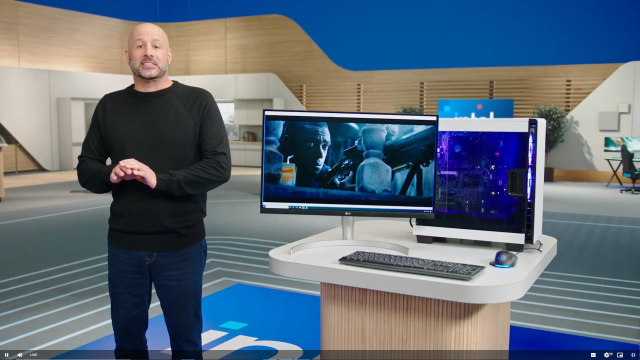Intel had a lot of processor announcements today, everything from laptops and Chromebooks to desktops and its vPro platform. There was something for nearly every industry segment — it was a lot. But the news that’s probably at the front of everyone’s mind is Intel’s 11th-gen desktop processors, aka Rocket Lake. What’s the core count? The boost clock? Is it a 10nm architecture? What are the SKUs? Intel revealed most of that information, focusing on what it says will be its flagship 11th-gen desktop CPU, the Core i9-11900K. It also talked about a new GPU capability that could end up being extremely cool.
Its architecture is based on Cypress Cove, which consists of Ice Lake’s 10nm node ported back to 14nm combined with Tiger Lake graphics (Iris Xe graphics). It’s not a true 10nm desktop CPU like most of us probably envisioned, but it still is the first new desktop architecture from Intel in roughly five years — and with all the issues Intel has had shrinking its chip dies from 14nm to 10nm, perhaps this was the best solution to achieve better gen-to-gen performance.
Intel says its focus with its new 11th-gen desktop processors was to “maximise real world performance” across two different areas: increasing instructions Retired per Cycle (IPC), or how many instructions were completely executed, and maximizing frequency. Interestingly, Intel has abandoned the 10-core/20-thread architecture on its flagship processor to stick with 8-cores/16-threads, which it says was a necessary trade-off that resulted in better performance.
Porting the 10nm node back to a 14nm node, which is a larger design, meant Intel could only fit a maximum of 8-cores on the new desktop processors, but Intel says that resulted in a 19% IPC gain and a 50% graphics improvement gen-over-gen.
Intel claims a small gaming performance boost over AMD’s Ryzen 9 5900X CPU, between 2-8% depending on the game and overall PC configuration. The Ryzen 9 5900X is not AMD’s top-of-the-line processor, but it’s the SKU that the Core i9-11900K matches with the closest. Honestly, if Intel can actually pull off better performance than AMD’s 12-core/24-thread CPU at stock speeds, that’d be impressive and give Intel enthusiasts something to be excited about.
AMD’s Smart Access Memory might give the Ryzen 9 5900X an edge, at least until Intel and Nvidia come out with its own version, but Intel has two hurdles to jump over even with its purported speeds: Competitively pricing its 11th-gen desktop CPUs (the Ryzen 9 5900X is $859 in Australia), and convincing PC DIYers that its 11th-gen won’t be lacklustre like the 10th-gen flagship Core i9-10900K.
The Core i9-11900K will support up to a 5.3 GHz boost clock dual-core turbo and up to 4.8 GHz all-core turbo with Intel Thermal Velocity Boost just like the previous generation. It will also support up to DDR4-3200 memory, a new 500-series chipset, and will be backward compatible with 400-series chipsets and motherboards. So, if you already upgraded to an Intel 10th-gen CPU with a 400-series motherboard, you don’t need to run out and buy a new one. Still, it’s not as versatile as AMD’s motherboard compatibility. Intel moved to a new socket, so anyone moving from a 9th-gen processor or earlier will still have to buy a new motherboard. I appreciate the backward compatibility nevertheless.
But the most interesting part about these desktop CPUs is that Intel has figured out a way to enable both its integrated graphics with a discrete GPU at the same time. Historically, the integrated graphics has always been disabled by default when an end user or a system vendor enabled a discrete GPU in a desktop PC. They’ve never worked together, and discrete GPUs have way more power than integrated GPUs, so it’s always made more sense to use that GPU over the integrated one.
According to Intel, enabling both GPUs at the same time will allow users to maximise their discrete GPU for gaming and offload other tasks like streaming and recording to the integrated GPU. It’s a similar concept to a CPU offloading certain tasks to an Nvidia RTX GPU, for instance, but both methods can increase processing and rendering times.
It appears that Cypress Cove is letting Intel still do more with its 14nm node, and if any of its performance gains are true, then perhaps we’ve reached a point in the CPU discourse where die size will stop being one of the main focal points in the processor wars. Guess we’ll all find out soon, since Intel plans to release its 11th-gen desktop chips sometime in the first quarter of 2021. Intel didn’t say when exactly, nor provide any price points.
If it seems a little soon for Intel to come out with a new flagship CPU, you’re not alone, but it’s the same cadence in which Intel has been releasing new CPUs for the last several years. Intel released the Core i9-10900K in April 2020, so if it stays on schedule, it will be a little less than a year since the previous generation desktop processors were released. It released its i9-9900K at the end of 2018, the i7-8700K at the end of 2017, the i7-7700K at the beginning of 2017, and so on. For anyone who didn’t upgrade to a 10th-gen CPU, this is will be the generation of desktop processors to watch out for.
Editor’s Note: Release dates within this article are based in the U.S., but will be updated with local Australian dates as soon as we know more.

Comments